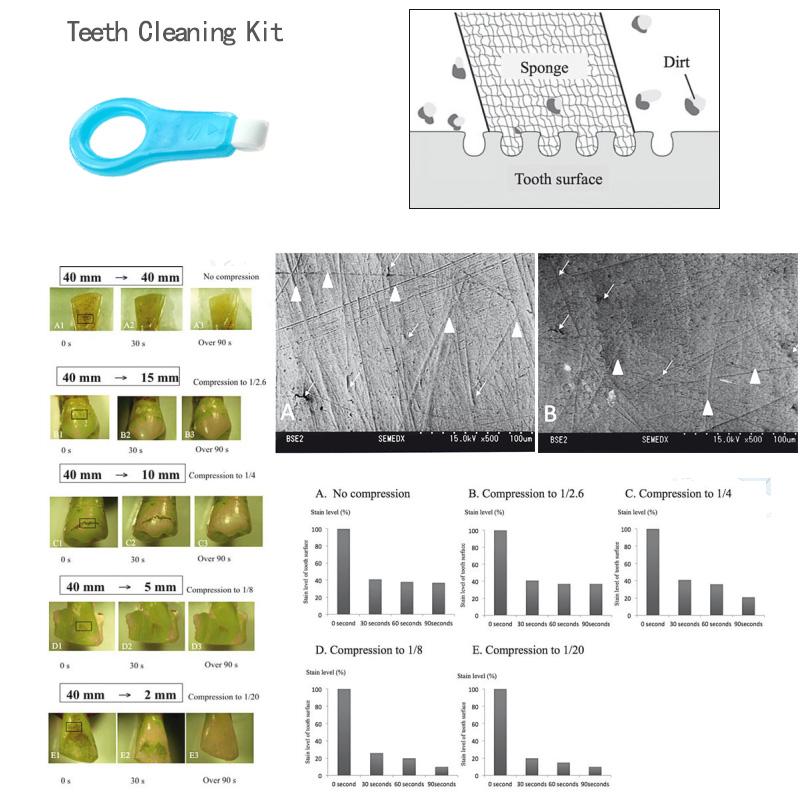The stain removal ability of teeth cleaning kit
Methods
the melamine sponge thickness of teeth cleaning kit was compressed and the destruction of the partition wall structure during the compression process was examined under a stereoscopic microscope. An extracted human tooth was cleaned by normal polishing or with teeth cleaning kit for 90 s. To evaluate the stain level, the tooth surfaces were photographed under a stereoscopic microscope at 0, 30, 60 and 90 s. The residual stained region was traced in a high-magnification photograph, and the stain intensity was presented as a change, relative to the intensity before the experiment (0 s).
Results
Mechanical cleaning by toothbrushing produced polishing scratches on the tooth surface, whereas use of the teeth cleaning kit resulted in only minimal scratches. As the compression level increased, the stain-removing effect tended to become stronger.
Conclusion
Teeth cleaning kit can remove stains from the tooth surface more effectively and less invasively compared to a conventional toothbrush. As no new scratches are made on the tooth surface when using a teeth cleaning kit brush, the risk of re-staining is reduced. Cleaning using a teeth cleaning kit brush can be easily and effectively performed at home and in a dental office.
Key words: teeth cleaning kit, stain removing, toothbrush, tooth cleaning
Demand for teeth whitening grown exponentially
The demand for teeth whitening treatment has grown almost exponentially in the last 20 years, and teeth- whitening products are now very popular1,2. To satisfy the increasing aesthetic demands of patients, we have to select a method with minimal adverse effects for patients requesting teeth whitening. In routine clinical practice, we frequently encounter patients who expect us to fully respond to their requests. During teeth whitening, external colouring substances, i.e. stains, are first removed, and, when this is not effective, whitening or bleaching is applied. When this is also ineffective, replacement treatment is performed. Patients are provided with sufficient explanation, regarding the main steps of teeth whitening. Patients who are concerned about stained teeth 1 Orthodontic division.
However, dental cleaning damages the teeth, regardless of the procedure, resulting in scratches of various sizes on the tooth surface, which increases the risk of re-staining. Teeth whitening using hydrogen peroxide damages the teeth due to the presence of residual hydroxide radicals, and it shortens the life-span of the tooth after replacement treatment in some cases3,4. Therefore, clinicians hesitate when promoting teeth whitening in dental offices. How- ever, patients request this treatment, because the merits surpass the issues. In the present situation, clinicians employ a method that is reliable and satisfies patients, while searching for a teeth whitening system that does not adversely affect the tooth quality.
Melamine foam for teeth whitening
Melamine foam scrapes dirt from micro concavities of the teeth, akin to the action of scooping. Soft sponge is made to soak up tap water, acting as a lubricant. Stains can be removed sufficiently by lightly rubbing the tooth surface with the sponge several
Stains in concavities which were unreachable by a toothbrush tip could not be removed. Since the partition wall of teeth cleaning kit was very thin, it could remove stains, akin to the action of scooping.
In the field of dentistry, melamine foam has been shown to be effective in composite resin- teeth cleaning.
The objective of this study was to investigate the effect of cleaning using teeth cleaning kit before aesthetic tooth whitening, in terms of stain removal in extracted teeth.
Materials and methods
teeth cleaning kit with a thickness of 40 mm was compressed at compression ratios of 0 (no compression), 1/2.6, 1/4, 1/8 and 1/20, and destruction of the partition wall structure during the compression process was examined under a stereoscopic microscope.
Five extracted human teeth were used. Each tooth surface was cleaned by normal toothbrushing or with melamine sponge for 90 s, at a stroke force of 300 g or less. To evaluate the stain level on the tooth surface, the teeth were photographed under a stereoscopic microscope every 30 s (0, 30, 60 and 90 s).
Normal polishing. Many scratches were observed on the tooth surface. The tooth surface cleaned using the novel cleaning tool alone . No scratches were produced. Arrows indicate the natural tooth surface concavities and arrowheads indicate artificial scratches.
Results
Non-replacement treatment: comparison with tooth cleaning
Mechanical cleaning by toothbrushing produced polishing scratches on the tooth surface. In contrast, teeth cleaning kit produced only minimal artificial polishing scratches, and natural concavities of the teeth were still noticeable .
Stain-removing effect of teeth cleaning kit compressed at different levels
Stains which were difficult to remove using commercial dentifrices and toothbrushes, were removed using melamine sponge toothbrushes. All compressed teeth cleaning kit toothbrushes showed a stain-removing effect. In particular, a marked effect was exhibited within a short period of time when the compression rate was high.
Discussion
In this report, we suggest that teeth cleaning kit can remove stain from the tooth surface more effectively and less invasively compared to conventional toothbrushes. Tanaka etal reported that melamine foam would be more effective for removal of stains on composite resin artificial teeth than by toothbrushing5. Repeated mechanical cleaning produces concavities and convexities on the tooth surface, and these changes in surface morphology may induce the re-adhesion of stains. Using a melamine brush instead of a conventional toothbrush could result in long-term cleanliness of the tooth surface.
All compressed teeth cleaning kit toothbrushes showed good stain removal in this study. As the compression level increased, the stain-removing effect tended to get stronger. Tanakaetal reported that four-fold compression of melamine foam has a good dimensional stability on heating/compression molding. Although the data are not shown, the frequency of irrigation increased as the compression rate rose, and the compression rate exhibiting both clinical operability and stain-removing effect was 1/4. Highly-compressed melamine would be less practical for use in a tooth- brush, because it has a low water absorption rate.
Although the physical properties of teeth cleaning kit are very similar to those of soft polyethylene foam and polyurethane, the stain-removing effect of melamine foam is superior. The main reason is the partition wall thickness being thinner than 0.5 µm, which enables it to enter small concavities on the tooth surface and allow it to scrape residual staining substances, akin to the action of scooping. The partition wall tips are always ablated and a new surface appropriately appears, retaining the cleaning function. In addition, teeth cleaning kit is very soft and unlikely to make a new scratch on the hard tooth tissue; thus, the frequency of staining does not change.
In this experiment, we used an extracted tooth for testing the stain-removing ability of melamine foam. In terms of daily use, it is difficult to brush the posterior teeth with a large sponge, so it is necessary to make the brushing region smaller for use in the oral cavity. Given that melamine itself is very soft, greater brushing force may be required compared to the conventional method. Also, the supporting part of the toothbrush comes into direct contact with the tooth surface if the thickness is not adequate. Therefore, further research is required to determine the size and structure of the novel toothbrush

The stain removal ability of teeth cleaning kit
Conclusions
teeth cleaning kit removed stains from the tooth surface
more effectively and less invasively compared to conventional toothbrushes. No new scratches were made on
the tooth surface when using a teeth cleaning kit brush,
therefore reducing the risk of re-staining. Cleaning using a teeth cleaning kit brush can be easily and effectively performed at home and in a dental office.
Acknowledgments
The authors would like to acknowledge the financial support of the Nishio Company in Chiba, Japan and the Daimonji Company in Tokyo, Japan.
Conflict of interest The authors reported no conflicts of interest related to this study.
Author contribution
Dr Takero Otsuka, who carried out the research and wrote the paper, and Dr Toshitsugu Kawata, who directed the research.


